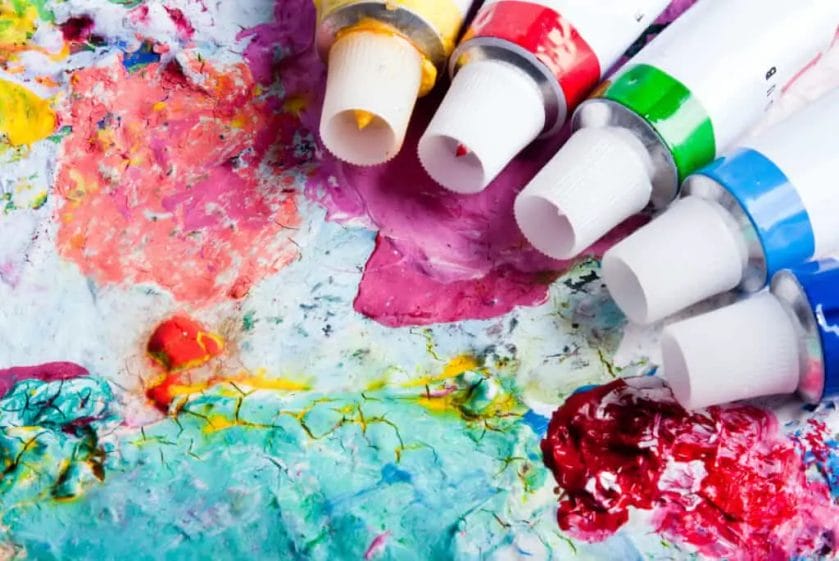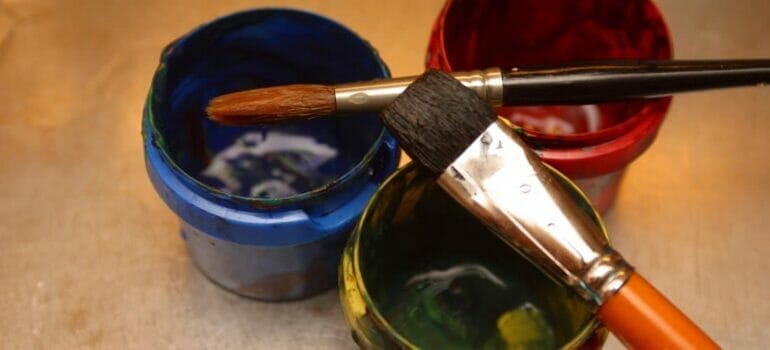Having trouble with dried acrylic paint? Don’t worry, we’ve got you covered! Whether you’re an artist or a DIY enthusiast, finding dried acrylic paint on your brushes, clothes, or surfaces can be frustrating. But fear not, in this guide, we’ll show you effective techniques to fix dried acrylic paint. From using solvents to soaking in water, we’ll provide you with simple and practical solutions to revive your dried acrylic paint and get you back to your creative projects in no time! Read on to learn more.

Step-by-Step Guide to Restoring Dried Acrylic Paint
If you’re an artist or a hobbyist who works with acrylic paint, you may have encountered the frustrating situation of finding your paint dried up and unusable. However, don’t worry! With a few simple steps, you can easily restore dried acrylic paint and get back to creating beautiful works of art. In this section, we will provide you with a step-by-step guide to help you revive your dried acrylic paint.
Step 1: Gather Your Supplies
Before you begin the restoration process, make sure you have all the necessary supplies. You will need the following:
- A container or palette
- Clean water
- Acrylic painting medium or acrylic flow improver
- A palette knife or paintbrush
- A spray bottle filled with water
Step 2: Prepare the Surface
Start by preparing the surface where you will be working. Lay down some newspaper or a plastic sheet to protect the area from any paint splatters or spills.
Step 3: Assess the Paint
Take a close look at the dried acrylic paint. Check if it is completely solid or if there are any clumps. If there are clumps, you may need to remove them before attempting to restore the paint.
Step 4: Add Water
The next step is to add water to the dried paint. Begin by using a spray bottle to mist the surface of the paint lightly. This will help rehydrate it and soften the dried layer.
Step 5: Mix in Acrylic Medium or Flow Improver
To further restore the paint’s consistency and improve its flow, add a small amount of acrylic painting medium or flow improver to the paint. Use a palette knife or paintbrush to mix it in thoroughly.
Step 6: Test the Paint
Once you’ve added the medium or flow improver, test the paint’s consistency. Dip your paintbrush into the restored paint and apply it to a test surface. Check if the paint spreads smoothly and evenly. If it still feels too thick or clumpy, add a bit more medium or flow improver and mix well.
Step 7: Store and Seal
If you have successfully restored your acrylic paint, it’s important to store it properly to prevent it from drying out again. Transfer the paint to a sealable container or palette and make sure to close it tightly after each use. This will help preserve the paint’s quality for future use.
Step 8: Clean Up
After you’ve finished restoring your dried acrylic paint, don’t forget to clean up your workspace. Wash your brushes and palette knife thoroughly with water and mild soap. Dispose of any used materials properly.
In summary, restoring dried acrylic paint is a relatively simple process. By following these step-by-step instructions, you can easily revive your dried-up paint and continue your artistic endeavors without any interruption. Remember to store your restored paint properly to maintain its usability in the long run. Now you can confidently rescue your dried acrylic paint and bring your artistic visions to life!

Common Methods for Fixing Dry Acrylic Paint
Acrylic paint is a popular medium for artists due to its versatility and vibrant colors. However, sometimes acrylic paint can dry out, making it difficult to work with or causing unwanted imperfections in your artwork. Fortunately, there are several common methods for fixing dry acrylic paint that can help restore its usability and quality. In this section, we will explore some of these techniques.
1. Adding Water
One of the easiest and most common methods for fixing dry acrylic paint is by adding water to rehydrate the paint. Start by spritzing water onto the dried paint using a spray bottle or by using a wet brush and dipping it into water. Allow the water to sit on the surface of the paint for a few minutes, then gently mix the water into the paint using a palette knife or brush. This will help to soften the paint and make it more fluid. However, be cautious not to add too much water, as it can dilute the paint and affect its opacity and adhesion.
2. Using a Palette Knife
If your dried acrylic paint has become clumpy or chunky, using a palette knife can help break up the dried paint and make it smoother. Begin by scraping the surface of the paint with a palette knife, applying pressure to break up any hardened areas. Once the paint has been loosened, you can add a small amount of water or acrylic medium to further soften it. Mix the paint with the palette knife until it reaches a smooth consistency.
3. Adding Acrylic Retarder
Acrylic retarder is a product specifically designed to slow down the drying time of acrylic paint. If your acrylic paint has dried too quickly, adding a few drops of acrylic retarder can help extend the working time of the paint and make it easier to manipulate. Simply mix the retarder with the dried paint using a brush or palette knife until it is fully incorporated. Keep in mind that using too much retarder can affect the overall drying time and adhesion of the paint.
4. Layering with Fresh Paint
If your dried acrylic paint has become patchy or uneven, you can fix it by layering fresh paint over the dried areas. Start by applying a thin layer of fresh paint onto the dried surface, using a brush or palette knife. Blend the fresh paint with the dried paint to create a seamless transition. Allow the layers to dry completely before adding additional layers if needed. This method is particularly useful for correcting color discrepancies or adding depth to your artwork.
5. Sanding and Repainting
In some cases, the dried acrylic paint may be too damaged or uneven to fix with the previous methods. If this is the case, sanding the surface of the dried paint can help create a smooth and even base for repainting. Use a fine-grit sandpaper or sanding block to gently sand away any imperfections or rough areas. Once the surface is smooth, you can repaint over it with fresh acrylic paint to achieve the desired result.
Summary
Fixing dry acrylic paint is a common challenge for artists, but there are several effective methods for restoring its usability. Adding water to rehydrate the paint, using a palette knife to break up clumps, adding acrylic retarder to extend drying time, layering fresh paint over dried areas, and sanding and repainting are all viable options. Experiment with these methods to find the best solution for your specific situation, and remember to practice proper paint storage techniques to prevent paint from drying out in the future.

Proven Techniques to Soften and Reuse Dried Acrylic Paint
Acrylic paint is a popular choice among artists and crafters due to its versatility, vibrant colors, and quick drying time. However, if you accidentally leave your acrylic paint to dry on a palette or brush, it can become hard and difficult to work with. But fear not! There are several proven techniques you can use to soften and reuse dried acrylic paint, saving you time and money.
1. Rehydrating with Water
One of the easiest and most common methods to soften dried acrylic paint is to rehydrate it with water. Simply dampen a clean brush or sponge with water and gently rub it over the dried paint. Gradually, the water will penetrate the dried paint, softening it and making it easier to mix and spread. Be careful not to use too much water, as it can dilute the paint’s pigment and affect the color intensity.
2. Using Acrylic Mediums
Acrylic mediums are specially formulated products that can be added to acrylic paint to alter its consistency and texture. When dealing with dried acrylic paint, you can use an acrylic medium, such as a gel or texture paste, to soften and revive the paint. Simply mix a small amount of the medium into the dried paint until it reaches the desired consistency. This method not only softens the paint but also retains its original color and properties.
3. Adding Acrylic Retarder
An acrylic retarder is an additive that slows down the drying time of acrylic paint. By adding a few drops of acrylic retarder to dried paint, you can extend the working time and make the paint more pliable. This method is especially useful if you want to blend or layer colors, as it gives you more control over the paint’s drying process. Mix the retarder with the dried paint thoroughly until it reaches a smooth and workable consistency.
4. Utilizing Isopropyl Alcohol
If your dried acrylic paint is particularly stubborn, you can try using isopropyl alcohol to soften it. Moisten a cloth or cotton ball with isopropyl alcohol and gently rub it over the dried paint. The alcohol will break down the paint’s dried surface, allowing you to scrape or wipe off the softened paint. However, be cautious when using isopropyl alcohol, as it can affect the color and integrity of the paint. Test it on a small, inconspicuous area first before applying it to the entire surface.
5. Scraping and Reconstituting
In cases where the dried acrylic paint is too hard to soften with the methods mentioned above, you can try scraping off the dried paint and reconstituting it. Use a palette knife or razor blade to carefully scrape away the dried paint from the palette or surface. Once you have removed the dried paint, place it on a mixing palette or surface and add small amounts of water or acrylic medium. Mix and knead the paint until it becomes soft and workable again.
6. Prevention is Key
While it’s great to have techniques to soften and reuse dried acrylic paint, it’s always best to prevent it from drying in the first place. Here are a few tips to keep your acrylic paint from drying out:
- Keep your palette covered when not in use to prevent the paint from drying.
- Mist your palette with water or use a palette wetting spray to keep the paint moist.
- Store your acrylic paints in airtight containers or tubes to preserve their freshness.
- Seal your paintbrushes in plastic bags or wrap them in damp paper towels to prevent the paint from drying on the bristles.
In summary, there are various techniques you can employ to soften and reuse dried acrylic paint. Whether you choose to rehydrate it with water, use acrylic mediums or retarders, utilize isopropyl alcohol, or scrape and reconstitute the dried paint, these methods offer effective solutions to revive your dried acrylic paint and extend its usability. Remember, prevention is always better than cure, so take the necessary precautions to keep your paint from drying out in the first place.
Expert Advice on Salvaging Dried Acrylic Paint
Acrylic paint is a versatile and popular medium among artists due to its vibrant colors, quick drying time, and ability to create different textures. However, if you accidentally leave your acrylic paint to dry out, it can be frustrating. The good news is that there are several techniques and expert tips to salvage dried acrylic paint and bring it back to life. In this section, we will discuss the best methods recommended by experts in the field.
1. Rehydrating with Water
If your acrylic paint has begun to dry on the palette or brush, you can try rehydrating it with water. Start by spraying a light mist of water over the dried paint. After letting it sit for a few minutes, gently mix the paint with a palette knife or brush. Gradually add more water and continue mixing until you achieve the desired consistency.
2. Using Acrylic Mediums
Acrylic mediums are specially formulated products that can be used to alter the characteristics of acrylic paint. In the case of dried acrylic paint, adding an acrylic medium can help rehydrate and revive the paint. Simply mix a few drops of the medium into the dried paint and continue to mix until the desired consistency is achieved. There are different types of acrylic mediums available, such as gel medium for thickening or flow release medium for thinning the paint.
3. Alcohol Solution
Another effective method to salvage dried acrylic paint is by using an alcohol solution. Mix equal parts of rubbing alcohol and water in a spray bottle. Lightly spray the solution onto the dried paint and let it sit for a few minutes. Then use a palette knife or brush to blend and mix the paint. Repeat the process if necessary until the paint reaches the desired consistency.
4. Working with Palette Wetting Spray
Palette wetting sprays are designed to keep acrylic paint on a palette moist for an extended period. However, they can also be used for reviving dried acrylic paint. Spray a fine mist of the palette wetting spray onto the dried paint and let it sit for a few minutes. Use a palette knife or brush to mix the paint and add more spray as needed. This method works best for small amounts of dried paint.
5. Rehydrating with Slow-Drying Medium
If you frequently encounter the issue of dried acrylic paint, you may consider investing in a slow-drying medium. Mix a small amount of slow-drying medium with the dried paint and thoroughly blend it using a palette knife or brush. The slow-drying medium will keep the paint moist and workable for a longer period, allowing you more time to work on your artwork.
6. Preventing Drying in the First Place
While it is possible to salvage dried acrylic paint, it is always best to prevent it from drying out in the first place. Here are a few tips to help you avoid this issue:
In summary, drying out acrylic paint can be frustrating, but with the right techniques, you can salvage and revive it. Whether it’s rehydrating with water or using specialized mediums, these expert tips will help you bring your dried acrylic paint back to life and continue creating your masterpiece.
FAQs
1. How can I fix dried acrylic paint?
To fix dried acrylic paint, you can try soaking the dried paint in warm water or using a paint thinner or solvent to soften it. Scraping or sanding gently can also help remove the dried paint. If the paint has dried completely, it may be difficult to fix, and you may need to repaint the area.
2. Can I revive dried acrylic paint?
In some cases, you may be able to revive dried acrylic paint by adding water or a specialized acrylic paint medium. Mix the dried paint with water or the medium, and knead it until the paint becomes smooth and workable again. However, this may not always be successful, especially if the paint has dried for a long time.
3. How can I prevent acrylic paint from drying out?
To prevent acrylic paint from drying out, make sure to close the paint containers tightly after use. Store the containers in a cool, dry place away from direct sunlight. You can also use a palette with a lid or airtight containers to keep your paint wet for longer periods during painting sessions.
Conclusion
In conclusion, fixing dried acrylic paint is a common challenge faced by artists and DIY enthusiasts. However, with the right techniques and tools, it is possible to revive and restore the paint to its original state. By using methods like rehydrating with water, scraping off the dry layers gently, or using solvents like rubbing alcohol or acetone, it is possible to soften and reconstitute dried acrylic paint. Additionally, proper storage and maintenance of acrylic paint can prevent it from drying out in the first place. Remember to always test these methods on a small area before applying them to the entire surface, and exercise caution to avoid damaging your artwork or surfaces. With a little patience and care, you can revive your dried acrylic paint and continue creating beautiful works of art.
So, don’t let dried acrylic paint discourage you. Embrace it as an opportunity to experiment with different techniques and explore new possibilities. With the right approach and a little creativity, you can turn a dried-up mess into a stunning masterpiece. Whether you’re an artist, a DIY enthusiast, or just someone looking to fix a mishap, these methods will help you bring your dried acrylic paint back to life. So, roll up your sleeves, gather your supplies, and let your artistic journey continue with revitalized paint and endless possibilities.
